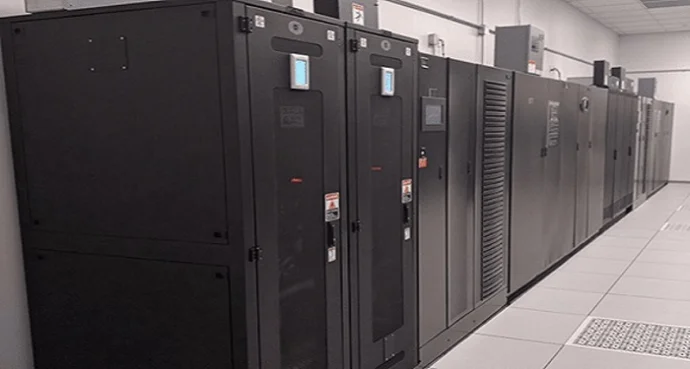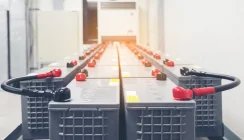Lithium-Ion UPS Systems For Data Centre Applications
The UPS system or uninterruptible power supply that we know today evolved from the oil industry and its need for backup power protection for computer operations in the 1960s. Today’s UPS systems provide a similar solution, but the world of backup power has changed dramatically since that period driven by a host of factors and technological developments.
Datacentre Backup Power
In the 1980s and 1990s computer and IT network adoption were two of the biggest drivers for development of the UPS and generator industries. These markets continue to evolve and one of the biggest drivers of the moment is their use within datacentre applications.
Datacentres provide a managed and secure environment in which to run IT servers. Datacentres can be classified as enterprise or co-location. Enterprise datacentres are own, managed and operated by and for the use of a single organisation. Co-location or Colo datacentres rent out space, racks and servers to their clients.
Virtualisation and Cloud computing continue to fuel datacentre market development as does the need for greater storage of information and its analysis. Whether the data is captured through Industry 4.0 or Internet of Things (IoT) applications, CCTV and access control security systems, general office applications or social media, it must be stored somewhere and with facilities that provide 24/7 coverage and immediate access.
Datacentre electricity usage is a growing concern for many operators and the countries they operate within. There is a continual drive to improve energy efficiency and reduce the demands placed on national grids by these large power generation users.
UPS System Developments
UPS manufacturers have continued to evolve their backup power technologies to meet the demands principally of the datacentre operators. UPS systems continue to push the boundaries of what can be achieved in terms of energy efficiency, compactness and modularity. Many UPS manufacturers can now achieve operating efficiencies of greater than 96.5% in full on-line operating mode with 97% close to becoming the next standard benchmark. 99% is also possible for systems that can run in full eco-mode. Modular UPS systems, once a niche product and now growing in popularity thanks to opportunities they provide for right-sizing and scalability in an UPS architecture that can grow both vertically and horizontally.
Generators are often deployed alongside UPS systems in datacentre environments. In applications like this, the UPS provides protection when mains power is present, and a backup battery set to power through small power outages or at least until the standby power generator power up to speed. Generator manufacturers are evolving their backup power sets to become more environmentally friendly in terms of emissions (fumes and noise), efficiency (fuel burn) and the type of fuel they can be run with.
UPS Batteries and Energy Storage Systems
That aside, one of the most interesting developments for UPS systems is its energy storing battery set. In an uninterruptible power supply, the battery of choice has traditionally been a valve-regulated lead acid (VRLA) type. This type of lead acid battery is most suited to a standby power application where it is called on infrequently to discharge either completely or to cover a generating set power up.
New battery technologies including Lithium-ion (Li-ion) provide an alternative energy storage source and a range of new backup power configurations. This is because Lithium-ion batteries are more suited to fast charge/recharge cycles and are the choice for nearly all Local Energy Storage (LES) systems as well as electric vehicles and smart phones and tablets.
When Li-ion batteries are installed with a UPS system, more potential applications open up. These run from use of the UPS system and its batteries to generate revenue through National Grid Demand Response type programmes to running the UPS system as a Virtual Power Plant (VPP). In the latter scenario, the UPS system Li-ion battery is charged overnight at the lowest cost electricity tariff and use during the day to power applications that would otherwise be running on higher tariff electricity supplies.
For Co-location datacentres, UPS systems can generate extra revenue when given the secondary duty of supporting a national grid. The Eaton ‘UPS as a Reserve’ can be applied to legacy as well as new-build UPS installations, as reported in Mission Critical Power – https://missioncriticalpower.uk/eaton-reports-pilot-success-ups-reserve/.
Edge Computing and The Industrial Internet of Things (IIoT)
Whilst the demand for datacentres continues to grow there are now new drivers pushing organisations to install more sophisticated on-site server rooms and network facilities. Edge computing is one aspect of this which couple with the Internet of Things and Industrial Internet will lead to a greater deployment of smaller backup power solutions on company premises. Without this, such organisations could lose the competitive edge that will be required to compete in the next decade through efficient data capture, storage, analysis and sharing on a 24/7 basis and from anywhere in the world.
Renewable Power Generation and Grid Independency
Energy storage system deployment is also rising rapidly coupled to a wider use of renewable power generation technologies including solar PV and wind turbine installations. Local energy storage systems allow companies and organisations to become more grid independent and to power their systems using energy generated renewably and then stored onsite in their own Lithium-ion energy storage solutions.
Coupled to this is the rising use of electric vehicles, which themselves rely on Li-ion battery technologies and at some point, a grid connection for recharging. In the not-to-distant future we could well see the Li-ion batteries in the electric vehicles in a car park being used to support the grid and the operation of your local datacentre and server room facilities.
The UPS specialists at Server Room Environments continue to develop innovative back-up power solutions working with our supply partners. If you would like to discuss your next UPS or energy storage project please contact us. We provide a free of charge UPS site survey.


























